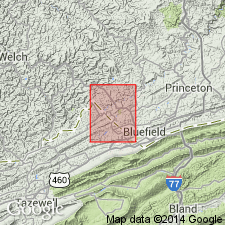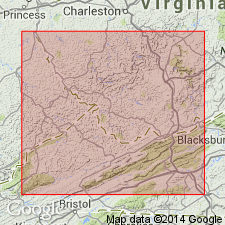
- Usage in publication:
-
- Bramwell Member*
- Modifications:
-
- Named
- Dominant lithology:
-
- Shale
- Siltstone
- AAPG geologic province:
-
- Appalachian basin
Summary:
Named the Bramwell Member of the Bluestone Formation for Bramwell, Mercer Co., WV. Consists of 31 meters of gray shale and siltstone. the Bramwell overlies the red and blue members above the Glady Fork Sandstone Member of the Bluestone Formation and underlies the member of Pennsylvanian age at the top of the Bluestone Formation. The Bramwell is of Late Mississippian age.
Source: GNU records (USGS DDS-6; Reston GNULEX).

- Usage in publication:
-
- Bramwell Member*
- Modifications:
-
- Overview
- AAPG geologic province:
-
- Appalachian basin
Summary:
The Bramwell Member of the Bluestone Formation correlates with the Imo Formation of northern Arkansas and possibly with the upper part of the Pitkin Limestone in northern Arkansas. Also, the Bramwell correlates with the Grove Church Shale at the top of the Chesterian series in the Illinois basin. These correlations are based on the ORTHOTETES n. sp. B-DIAPHRAGMUS n. sp. A Brachiopod Assemblage Zone and the ADETOGNATHUS UNICORNIS Conodont Zone.
Source: GNU records (USGS DDS-6; Reston GNULEX).
For more information, please contact Nancy Stamm, Geologic Names Committee Secretary.
Asterisk (*) indicates published by U.S. Geological Survey authors.
"No current usage" (†) implies that a name has been abandoned or has fallen into disuse. Former usage and, if known, replacement name given in parentheses ( ).
Slash (/) indicates name conflicts with nomenclatural guidelines (CSN, 1933; ACSN, 1961, 1970; NACSN, 1983, 2005, 2021). May be explained within brackets ([ ]).

